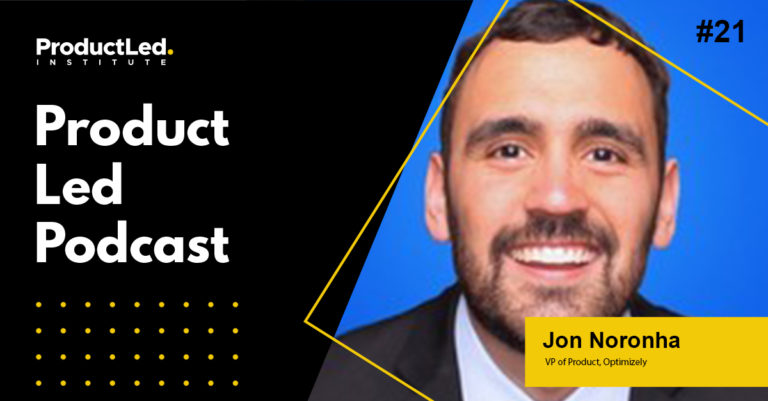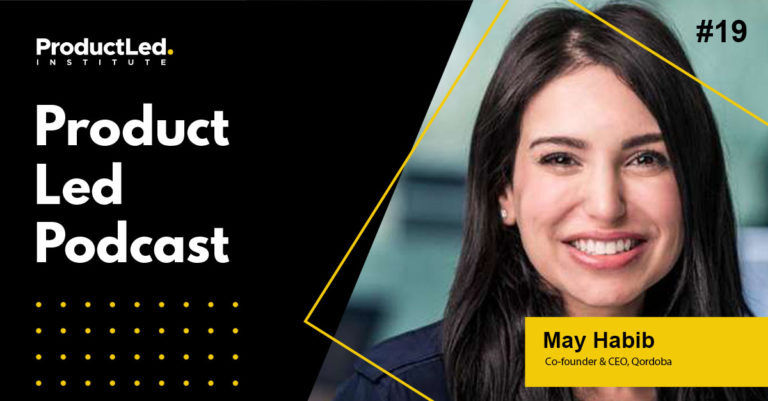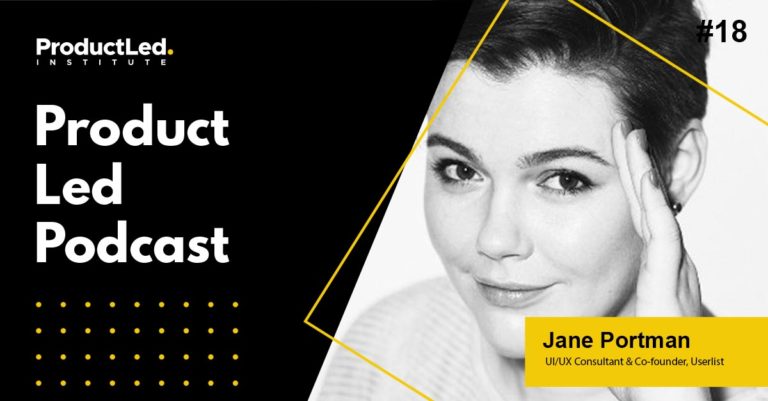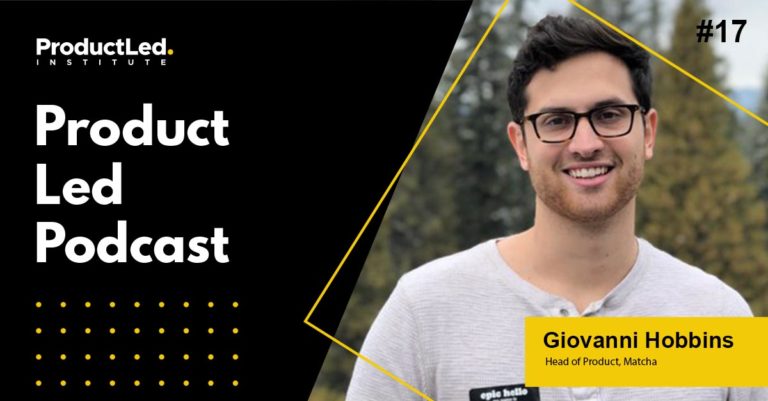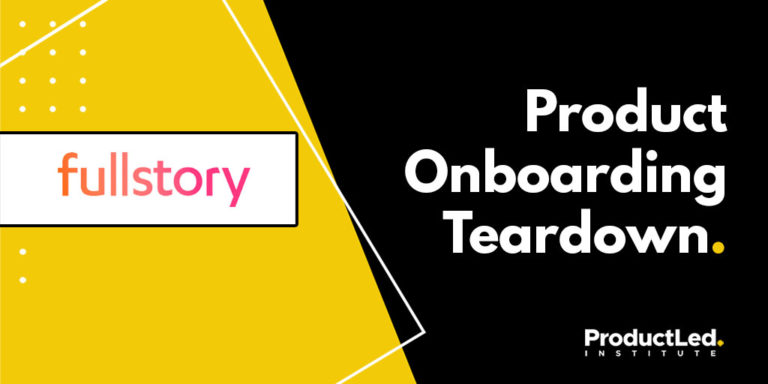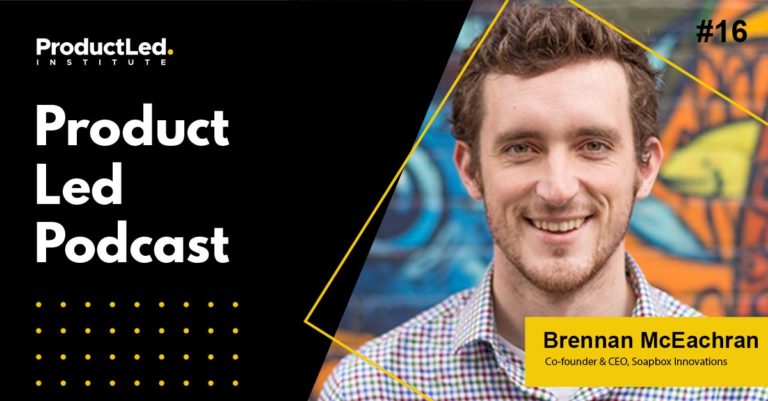If your users aren’t upgrading, chances are you’ll need to look beyond your onboarding or your free experience.
It could actually be your pricing strategy.
Many founders don’t prioritize pricing since they lack expertise on how to do it well. If you’re afraid to make any changes to your pricing, you’ll miss out on valuable insights
The good news is that you don’t have to get your pricing perfectly right the first time.
The biggest mistake you can make with your product pricing is to pick one pricing model and leave it alone forever. As your business evolves, as the competitive landscape changes, and as your customers’ needs shift, your pricing will need to be updated.
In this article, we’re going to make pricing way less scary and give you the confidence to choose a pricing strategy that fits your business and constantly improves it with smart experiments.
Here’s what we’ll cover:
- Value Metrics: The Unit of Value You Structure Your Billing Around
- Pricing Tactics: Packaging and Presenting Your Pricing
- A Four-Step Framework to Build Your SaaS Pricing Strategy
Change is hard, whether you’re shifting your pricing strategy or considering a completely new go-to-market strategy. Learning from others who have done it before you can make a world of difference. If you’re a founder, be sure to check out ProductLed Academy to help your users signup, get to value, and upgrade. You can learn more here.
Value Metrics: The Unit of Value You Structure Your Billing Around
Your SaaS pricing model is a combination of the value metrics you structure your billing around and the pricing tactics you use to package and present your product.
We’ll cover value metrics first. Your value metric is simply the unit of value you use to calculate the monthly or annual cost of your product.
Most SaaS companies choose one of the following value metrics:
- Flat Rate
- Usage-Based
- Per User
- Per Active User
- Per Feature
Below we’ll look at each in more detail and provide examples of companies that use each value metric.
Flat Rate: Access All Features for One Price
A flat rate pricing model offers a specific set of features for a single price that can be paid monthly or annually.
It’s the simplest way to structure your pricing, and many early-stage startups use it when they just want to gauge whether customers will pay for their product.
HoneyBook offers users access to their whole product with the option to pay monthly or annually:
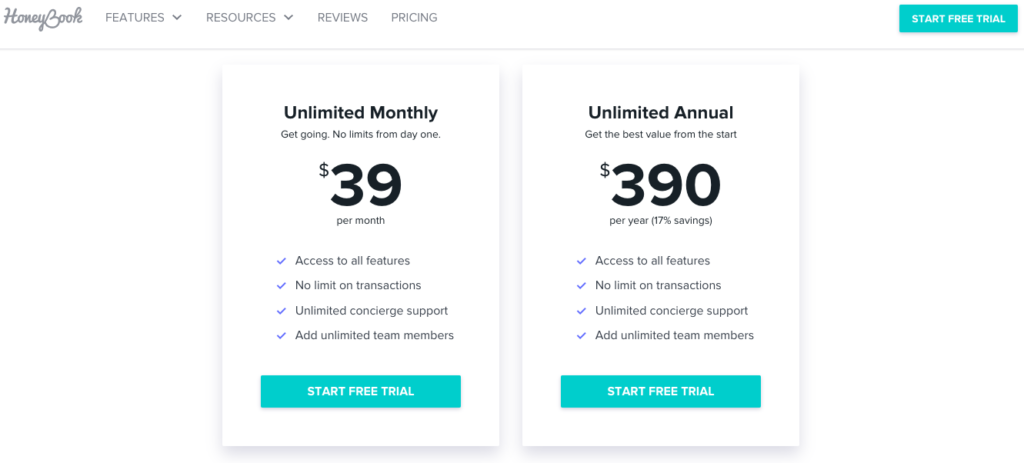
Flat rate pricing helps new customers avoid the decision fatigue that comes from seeing several options. But with flat rate pricing, you lose the opportunity to upsell power users on add-ons or higher-priced tiers, which can impact your profit margin.
It works best for products with a limited feature-set and only one buyer persona.
Usage-Based: Only Pay for What You Use
Usage-based pricing is also called pay as you go pricing because users are charged according to the amount they use the product. This metric works well for cloud storage service providers, for example, where a customer has a low barrier-to-entry if they only need a small amount of storage.
Cloud storage provider Snowflake offers a usage-based pricing model:
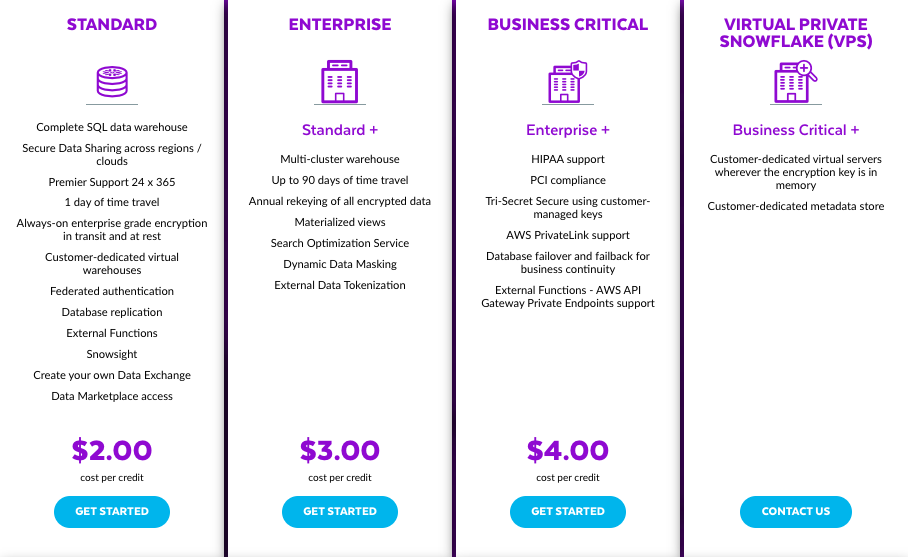
The downside of usage-based pricing is that it can lead to unpredictable monthly revenue for your business since pricing is tied to customers’ usage. And for some customers, the unpredictable monthly cost can be hard to budget for.
Per User: Pay per Team Member
Per user pricing means customers pay for the number of users who access the product. This metric offers customers a clear set of features that all team members have access to, and makes calculating costs simple.
Basecamp uses a per-user pricing model that offers great value for small businesses:
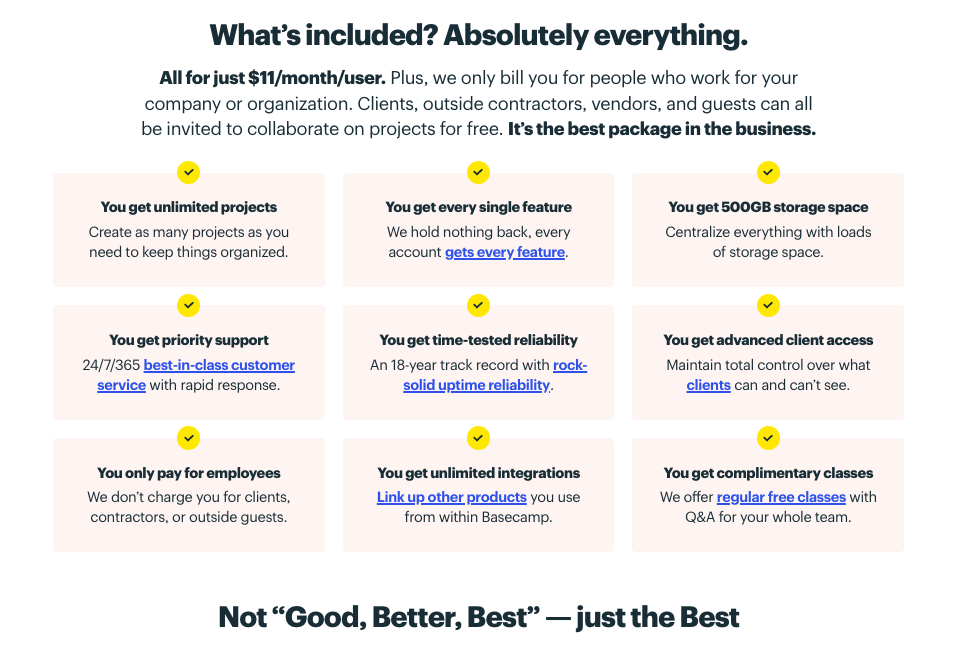
User-based pricing is the most common pricing plan for SaaS businesses, but it’s not a perfect fit for all businesses because it limits adoption. If only a few team members are using a tool, companies may see less value from it, which could lead them to churn. It’s also open to abuse if customers share logins between multiple users.
Per Active User: Don’t Pay for Inactive Team Members
Per active user pricing allows customers to onboard as many users as they want, but only pay for the users who are active in the tool. It’s a good pricing option for enterprise customers who are unsure how many employees will use a product on a regular basis.
Slack offers pricing based on active users. An enterprise customer begins paying for all users they onboard, then the payment model adjusts to only include active users:
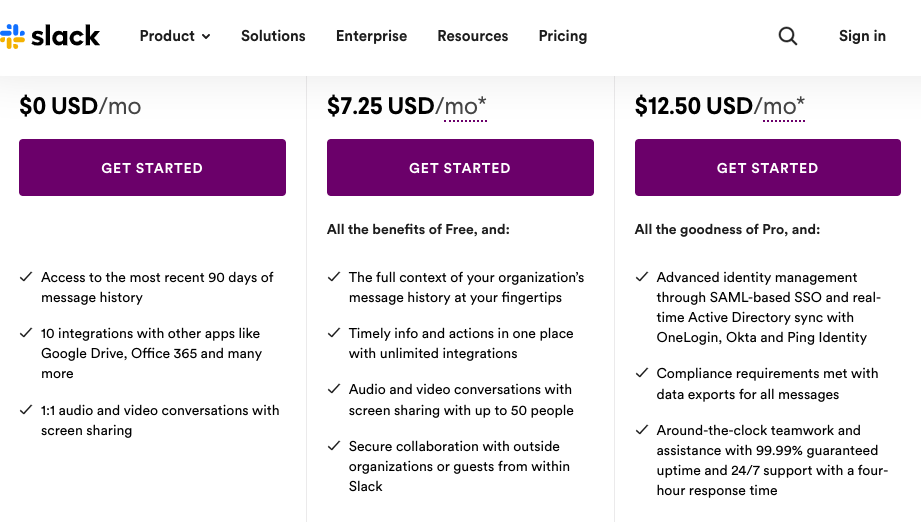

Per active user pricing may not be the best fit if your company serves small to medium businesses where the employee count is low.
Per Feature: Choose Which Features You Need
A feature-based pricing model gives customers the option to pick and choose what features they need in their subscription. It’s a good option for customers who know exactly what features they need, and what they don’t.
HubSpot has a free version of their product but also allows customers to customize their marketing, sales, service, and operations bundles:
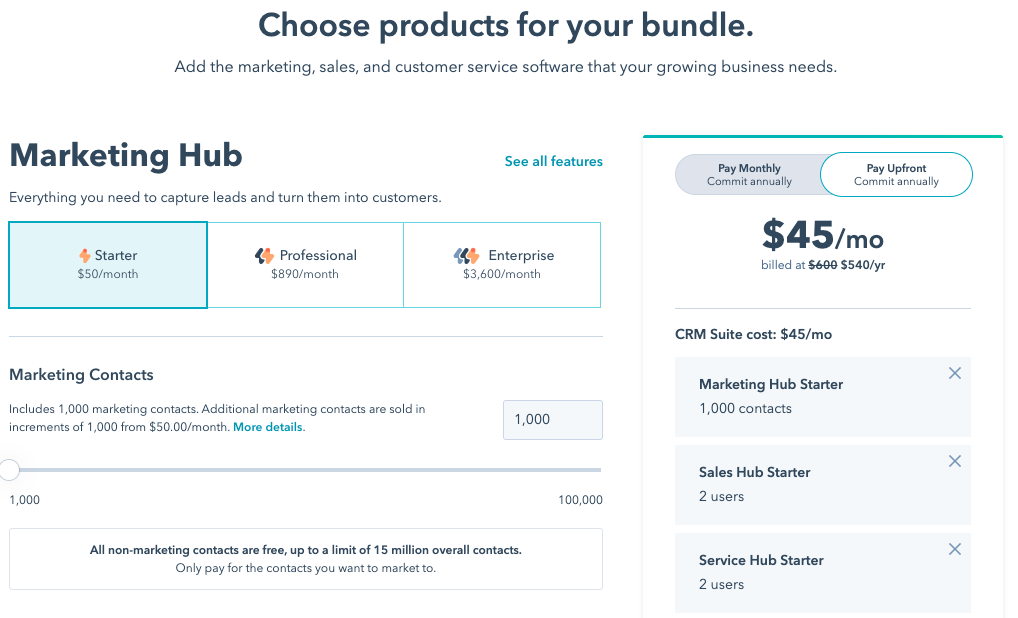
The downside of per feature pricing is that some customers might not have clarity at the beginning of the sales process on which features they need. This lack of clarity increases decision fatigue for customers.
Your value metric helps communicate your product’s intended use to the end-user.
Below we’ll look at options for presenting your product through pricing tactics.
Pricing Tactics: Packaging & Presenting Your Pricing
Pricing tactics are the ways you present your pricing to customers on your pricing page. They include options for combining pricing metrics together, psychological tricks to influence how customers perceive your pricing, and strategies to motivate customers to make a purchase. Here are five of the most common tactics SaaS companies use to present their pricing to their customers:
- Tiered Pricing Model
- Freemium Pricing Model
- Free Trial or Reduced-Price Trial
- Charm Pricing
- Decoy Pricing
Below, we’ll look at each in more detail.
Tiered Pricing Model: Divide Features Into Basic and Advanced Packages
This tactic offers customers multiple pricing tiers ranging from a basic package with limited features or capabilities to a premium package with all features or capabilities included. It’s a useful tactic for serving a variety of customer personas and allows you to capture a large customer base with your cheapest offering and then upsell your best users on more advanced features.
Many of the companies we’ve featured here use a tiered pricing package. Here’s a clear example from Zendesk:
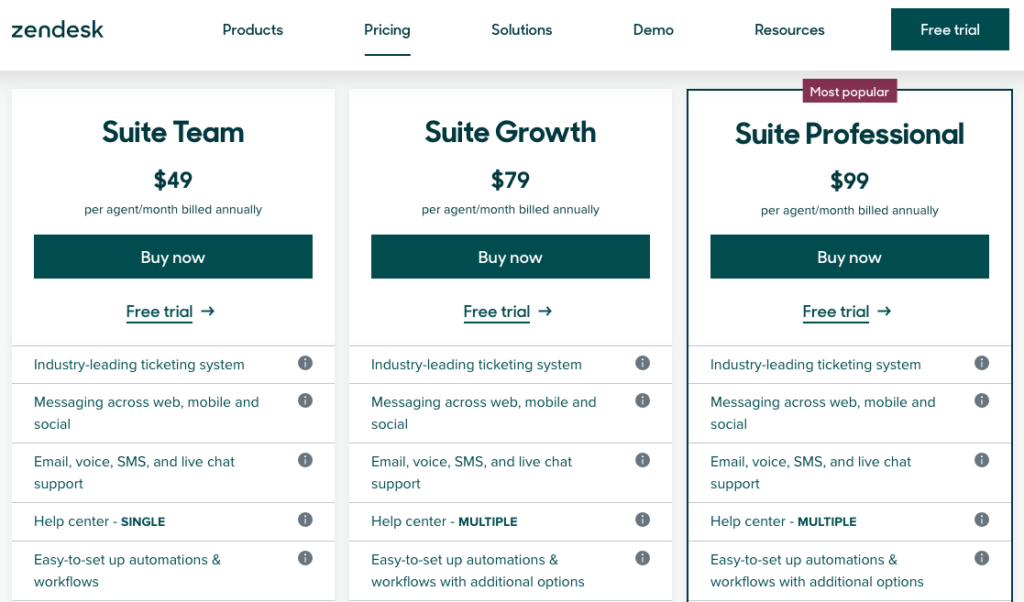
The downside of tiered packages is that the options can be confusing to customers, increasing decision fatigue.
Freemium Pricing Model: Free to All But Limited in Functionality
Freemium presents customers with a free version of a product that contains useful but limited features. This has become a popular tactic because of its ease of user adoption. As users of the free version find value and incorporate it into their workflow, they may run up against a usage limit or premium feature paywall, at which point they may upgrade to a paid package to get higher usage limits or access more features.
Dropbox offers a compelling freemium product that helps them acquire thousands of potential customers while keeping their customer acquisition costs low. Their free file storage system gives free users 2GB of storage, but they can earn more storage by referring other users.
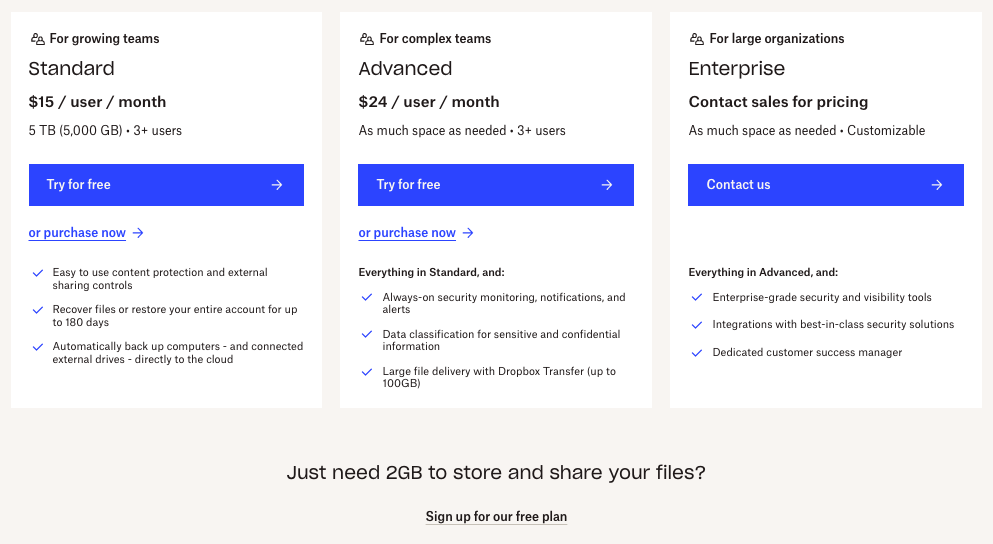
The challenge with using a freemium business model is understanding the customer’s use case well enough to turn free users into paid customers. Missing the mark results in low revenue as the majority of users stay in the free tier indefinitely.
Free or Reduced-Price Trial: Test Drive the Product Without Paying
Offering your potential customers a free or reduced-price trial lets them interact with all the features of your product for a limited time before buying (or for a nominal fee). It reduces risk for the customer because they can experience the value of the product before making a buying decision.
Hootsuite offers a 30-day trial to individuals and teams:

The downside of a free trial is that it can be difficult to get customers to experience the full value of the product during the trial period, especially for complex products requiring a lot of setup. If they don’t experience value in the free trial, they’ll be less likely to convert to paid than if they’d never tried the product at all.
Additionally, free trials can be abused by customers who use different email addresses to activate a new trial period.
Charm Pricing: Change the Customer’s Perception of the Price
Charm pricing is when the last pricing digit ends in a number like seven or nine. While there’s very little difference between $10.99 and $11.00, most people perceive $10.99 to be a better deal.
Here, Evernote uses charm pricing for their Personal and Professional plans:
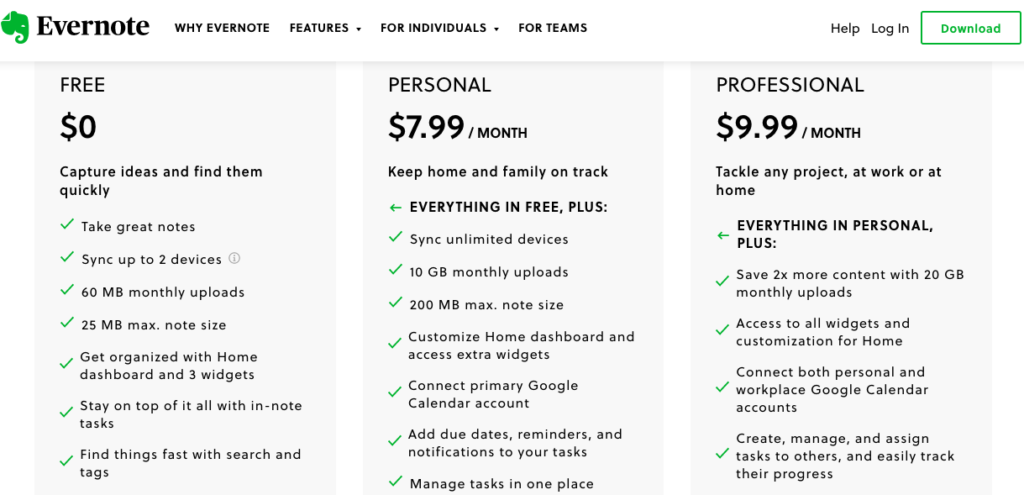
Charm pricing tends to be associated with bargain products, so if you want to position your software as a premium, luxury product, charm pricing might not be the best pricing model for you.
Decoy Pricing: Make the Choice Obvious
Decoy pricing is a tactic where several price options are displayed, but there is one clear choice that offers the greatest value. For example, a company will offer two options: one with the features that you need most for a reasonable amount of money, and the second with a few additional features but for a much higher price point. The first becomes the customer’s obvious choice because the comparison between the two is so exaggerated.
In this example, Mailchimp shows the highest price first and presents their Standard package as the obvious choice:
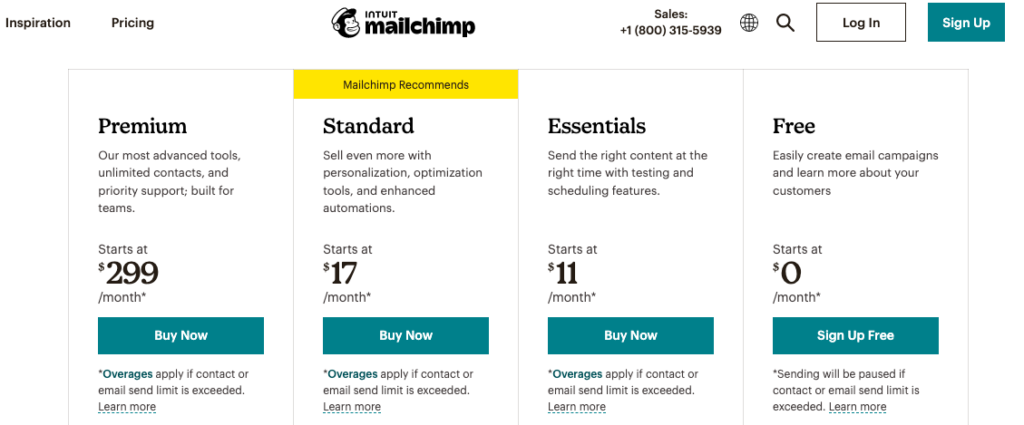
A Four-Step Framework to Build Your SaaS Pricing Strategy
Now that we’ve introduced the most common value metrics and pricing tactics, we’ll turn our focus to developing the right pricing strategy for your SaaS product.
Step 1: Determine Your Growth Strategy
Your growth strategy has two components that you need to define as the first step of building your SaaS pricing model:
- Growth goals: Will you choose an adoption-at-all-costs or an efficient growth option?
- Go-to-market strategy: Will customers interact with a Sales team or with the product itself?
Growth Goals
Companies that prioritize adoption at all costs aren't yet concerned with building a profitable product, and they have the capital runway to focus on rapid user adoption over profitable growth. For these companies, the decision-making process is simple: just pick a low price that will let as many customers as possible experience the value of your product.
For companies that prioritize efficient growth, profitability is more important than rapid user adoption. User growth remains an important factor, but covering the cost of the business through product sales is their primary objective. For these companies, some form of cost-based pricing will be a good starting point to make sure they’re covering their expenses.
In today’s macroeconomic environment of high interest rates and increasing inflation, more companies are choosing efficient growth. Venture capital firms have reduced their appetite for risk, and stakeholders are more interested in company growth fueled by product sales versus outside capital.
Go-to-market Strategy
There are two primary go-to-market strategies SaaS companies adopt: sales-led growth or product-led growth.
In a sales-led approach, a salesperson leads the customer through the buying process communicating the value of the product, providing demos, customizing the product package, and negotiating the price. Until the sale is made, the primary interaction the customer has with the product is through the salesperson.
A product-led organization flips the sales-led strategy on its head by focusing on the customer experience with the product before the sale is made. These companies use the product itself as the vehicle to engage, educate, and onboard the customer.
Your go-to-market strategy has huge implications on your pricing. Sales-led companies have the flexibility to negotiate a different price for each customer and make changes on the fly as market conditions change.
Product-led companies face more pressure to choose the right pricing strategy from the beginning because they make their pricing public. This makes it harder for product-led companies to adapt their pricing on the fly. But unlike sales-led companies, product-led companies can scale quickly without the expense of a Sales team since the product itself engages and onboards the customer.
Just as many companies are choosing an efficient growth option based on the current economic environment, many SaaS companies are moving to a product-led approach to reduce cost of customer acquisition (CAC), increase profitability, and provide a friction-less buying experience.
Step 2: Match Your Value Proposition with Your Customer’s Value Perception
In my eight years’ experience in product growth for B2B SaaS, I have yet to encounter a single deal where price was the reason why someone didn’t buy a product.
The dollar amount alone is almost never the problem. It’s the mismatch between the price and the customer’s perception of the value of the product that will sink a deal.
To make sure your price is aligned with the customer’s perception of your value, you need to understand your value proposition. Your value proposition is your promise to the customer of what outcomes they’ll achieve with your product.
For instance, Calendly automates the time-consuming process of booking meetings. Their value proposition is the ability to book meetings in a fraction of the time it takes when you have to manually coordinate schedules.
Assume, for example, that Calendly discovers that their Essentials plan ($8/month) saves most customers a minimum of three hours a month. For customers who value their time at $50 or $100 an hour, the price appears to be a great deal.
When you’re crystal clear about your value proposition, it becomes much easier to evaluate whether your pricing is aligned with the value you actually provide to customers.
Step 3: Pick a Value Metric That Aligns Your Pricing with User Success
As you work to define your value proposition, you may notice that some pricing models actually limit your ability to deliver on your promise to your customers.
For example, consider Slack. The app helps teams collaborate and share knowledge, and one of its key value propositions is the ability to be a central repository for all company communication. If Slack chose to charge per message (a form of usage-based pricing), they would actually incentivize companies to limit team communication on the platform. This would in turn limit the value of using Slack as a communication hub.
Instead, Slack’s value metric is built around price per active user. Since companies tend to add team members in response to growth and continued success, Slack’s value metric is well aligned with their end-user’s success.
When choosing a value metric, it’s important to choose a value metric that aligns the success of your business with the success of your end-user.
Step 4: Refine Your Pricing with Smart Experiments
As we mentioned before, many companies are afraid of making any changes to their pricing because they’re afraid of getting it wrong. But with so many possible ways to structure and present your pricing, it’s unreasonable to expect you’ll get it perfect on the first try.
A/B testing can be a helpful way to evaluate the impact of changes to your pricing structure. However, it’s not a good idea to run A/B tests where the variable is the dollar amount. There’s always the possibility that a customer will see both variants, leading them to choose the lower price even if they might have converted at the higher price.
Instead, use A/B tests to test the impact of different pricing tactics and positioning. Keep the dollar value the same, but switch up the marketing copy in each variant, or try moving a valuable feature into a lower tier to see if the conversion rate on that tier increases. A/B testing the way you present your pricing can help you pin-point what resonates with your end-users.
The key to monetization is to maximize experimentation. You want to make small changes that are measurable enough to learn from, but not so big that they have a negative impact on your business.
By lowering the risk of each change, you’ll make it easier to keep running tests until you’ve found a pricing model that helps you achieve your business goals. And with each change you make, stay focused on end-user success. If a change would prevent your core customers from achieving that success, don’t make it.
If you're struggling with pricing, join ProductLed Academy for expert help on how to get it right.
Optimizing your pricing model is just one key part of building a successful SaaS product, but it’s connected to every aspect of your business. In ProductLed Academy, we cover pricing as part of the ProductLed Method, so you can build a self-serve model that converts.
ProductLed Academy is a 12-month coaching program, where you'll work directly with Wes Bush to master each of the nine components of a successful product-led business (we spend around six weeks on each of these):
- Vision: What is your company really good at?
- User: Who do you serve best?
- Model: How do you create a ton of value for your users to win?
- Offer: Have you crafted an irresistible free offer for your ideal users?
- Experience: Have you created an effortless path to value for your users?
- Pricing: Is it easy for users to upgrade without talking to anyone?
- Data: Do you know where users are getting stuck in your product?
- Process: Do you have a growth process that enables your team to build out experiments, prioritize the high-impact ones, and launch the ones that are easiest?
- Team: Is your team full of A players capable of taking you to the next level?
While you can have one or more of these dialed in perfectly, if you’re missing one of these key players, you’re going to have a hard time with growth.
Apart from focusing on those key areas of your strategy, ProductLed Academy comes with:
- Weekly 60-minute group coaching call with Wes Bush, where you'll go through each of the components of the ProductLed Method (including pricing) to master a self-serve model.
- Weekly non-negotiable tasks to keep you accountable.
- Access to an exclusive ProductLed Founder Community so you can meet other ambitious founders and receive support 24/7.
- Access to the ProductLed Vault, where you'll gain access to all of our programs (including ProductLed Acquisition and Accelerator), templates, and frameworks.
If you're ready to break through to the next level and master your pricing strategy, be sure to check out ProductLed Academy.


